Adrenomedullin in the growth modulation and differentiation of acute myeloid leukemia cells
- Authors:
- Rosa Di Liddo
- Deborah Bridi
- Michele Gottardi
- Sergio De Angeli
- Claudio Grandi
- Alessia Tasso
- Thomas Bertalot
- Giovanni Martinelli
- Filippo Gherlinzoni
- Maria Teresa Conconi
-
Affiliations: Department of Pharmaceutical and Pharmacological Sciences, University of Padova, Padova, Italy, Department of Haematology, General Hospital, Treviso, Italy, Treviso Cord Blood Bank and Hematopoietic Cell Culture Laboratory, Transfusional Center, General Hospital, Treviso, Italy, Institute of Haematology ‘L. and A. Seràgnoli’, Department of Experimental, Diagnostic and Specialty Medicine, ‘S. Orsola-Malpighi’ University Hospital, University of Bologna, Bologna, Italy - Published online on: February 2, 2016 https://doi.org/10.3892/ijo.2016.3370
- Pages: 1659-1669
This article is mentioned in:
Abstract
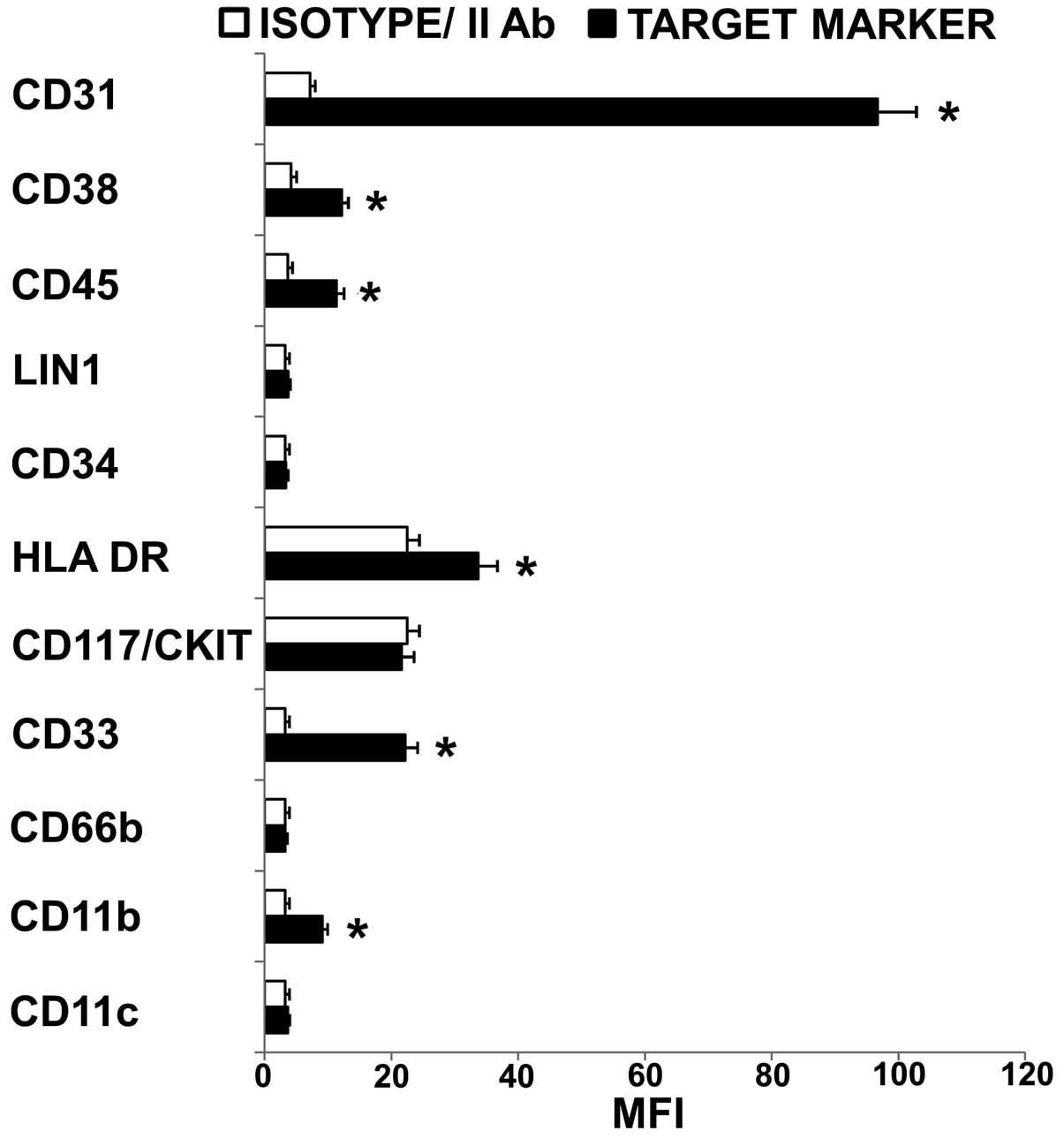 |
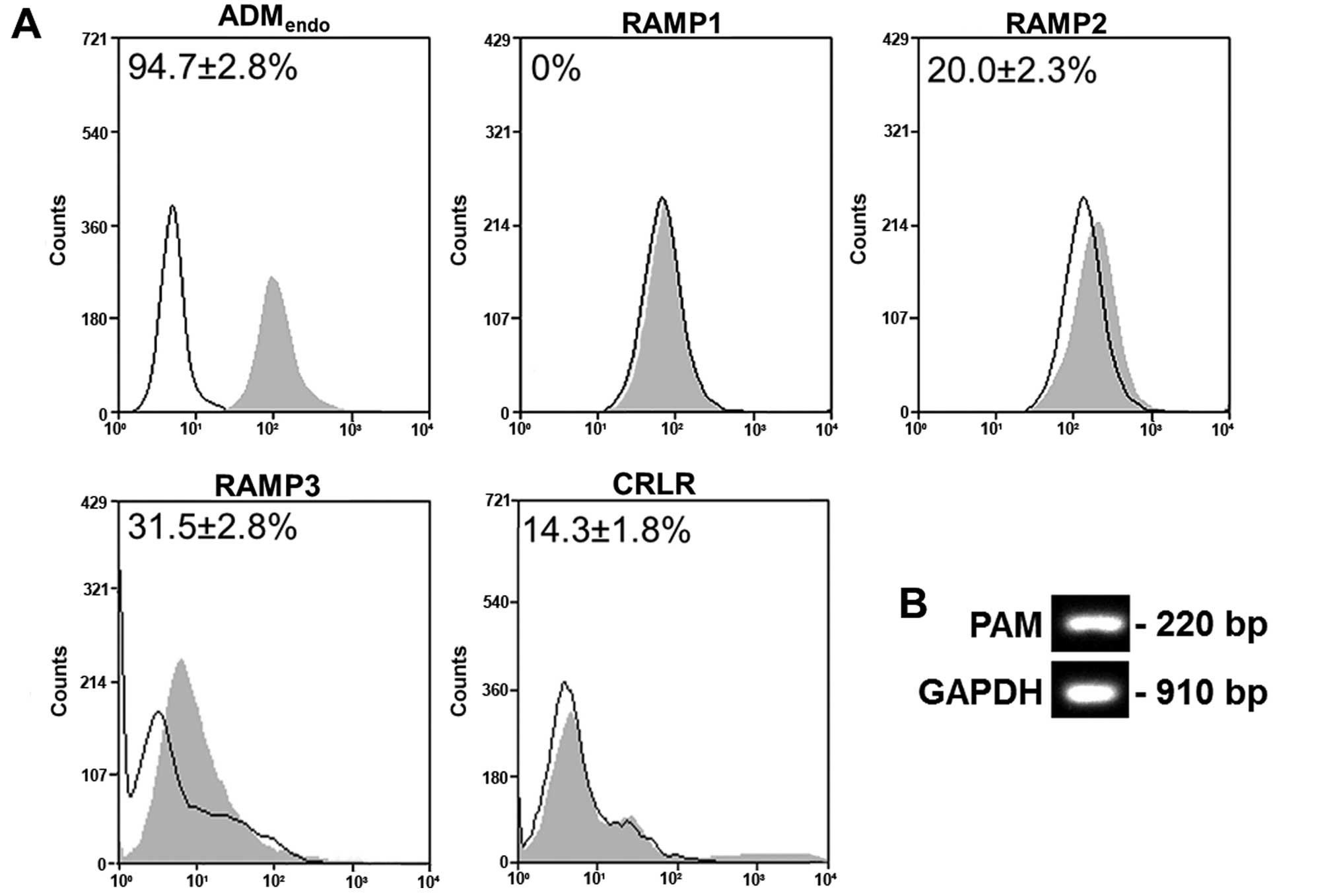 |
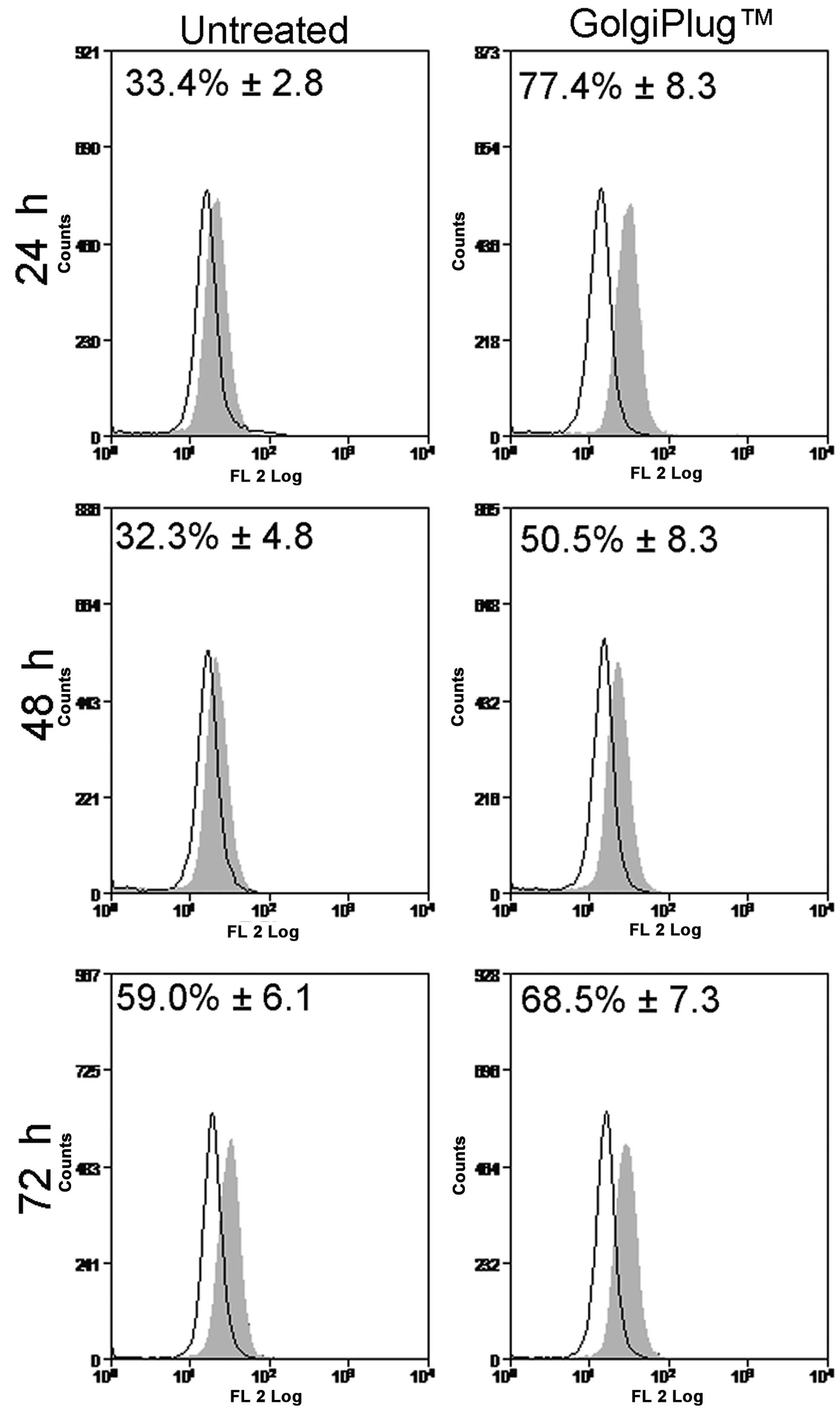 |
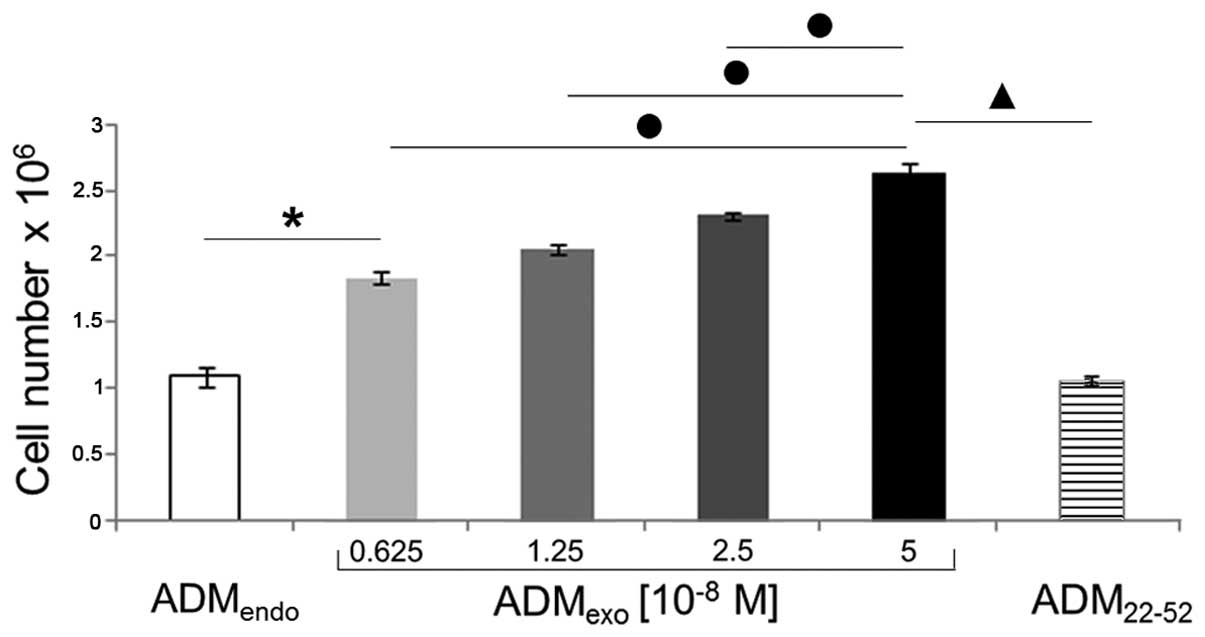 |
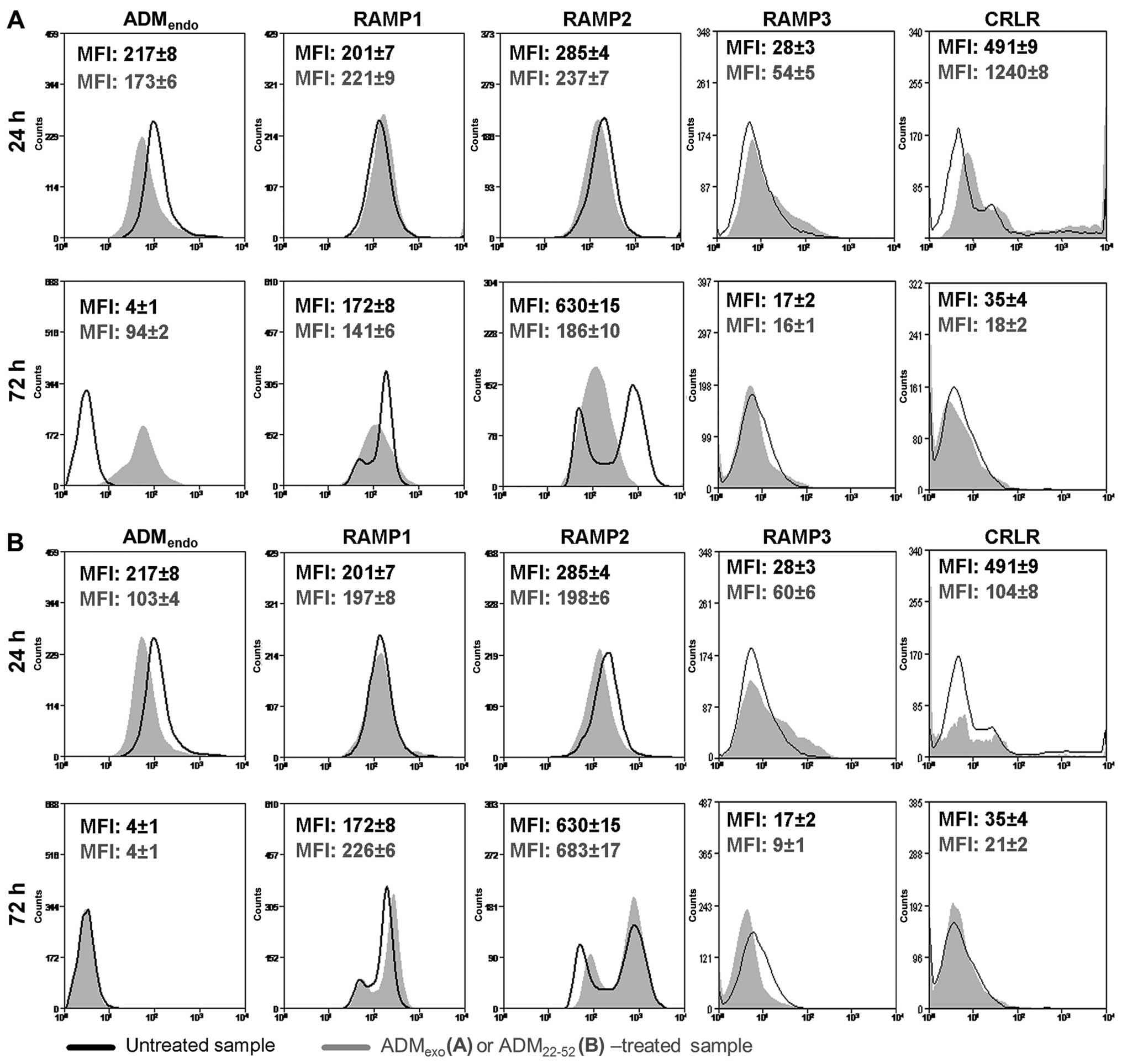 |
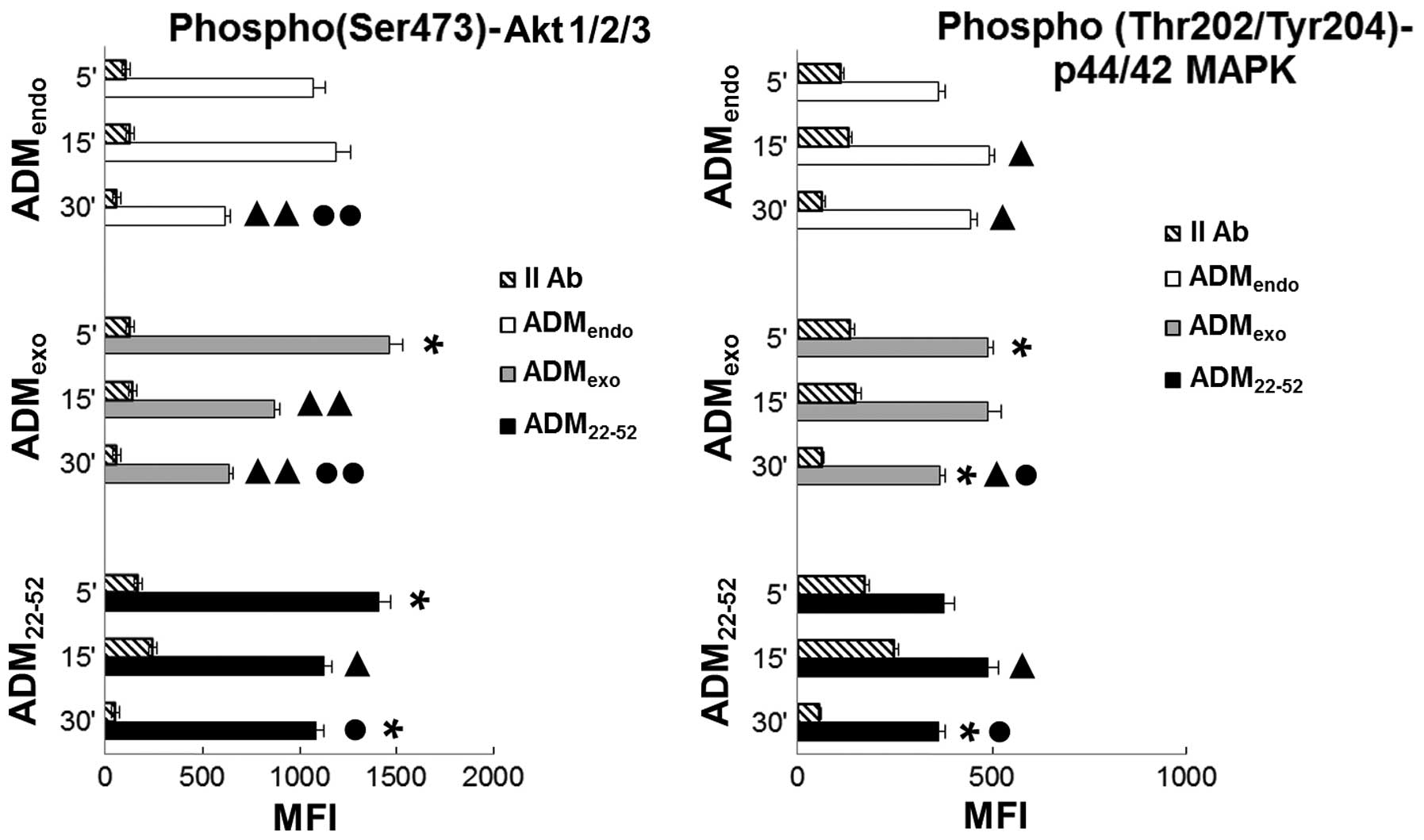 |
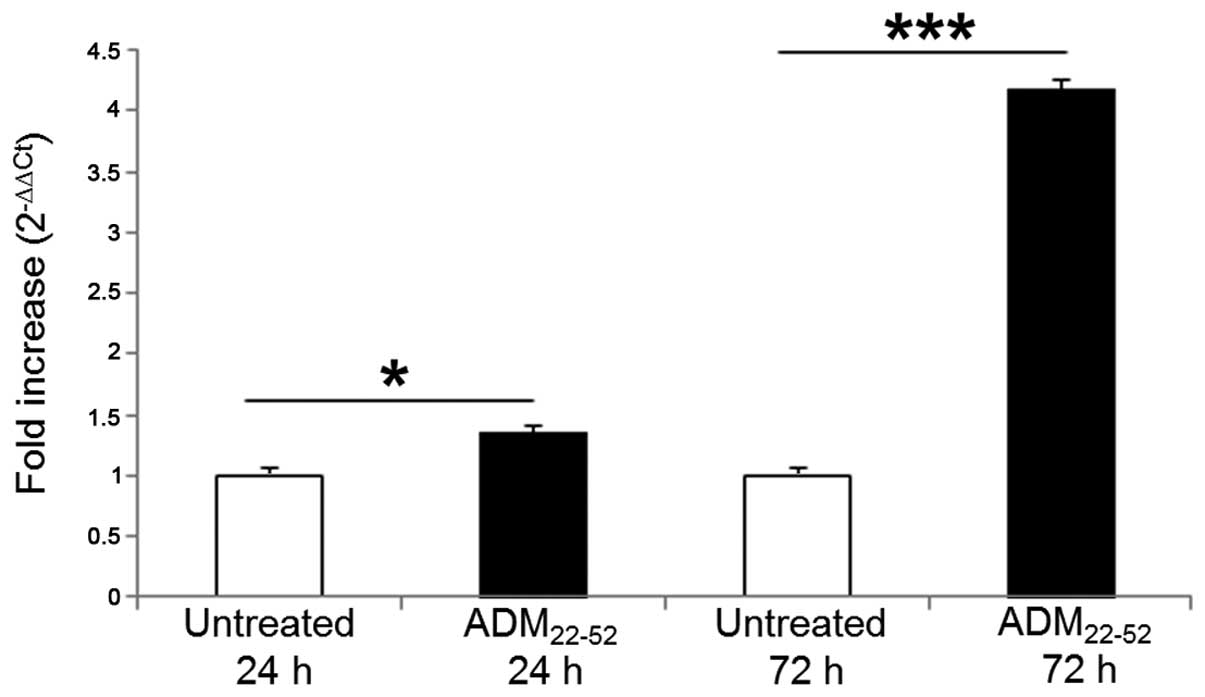 |
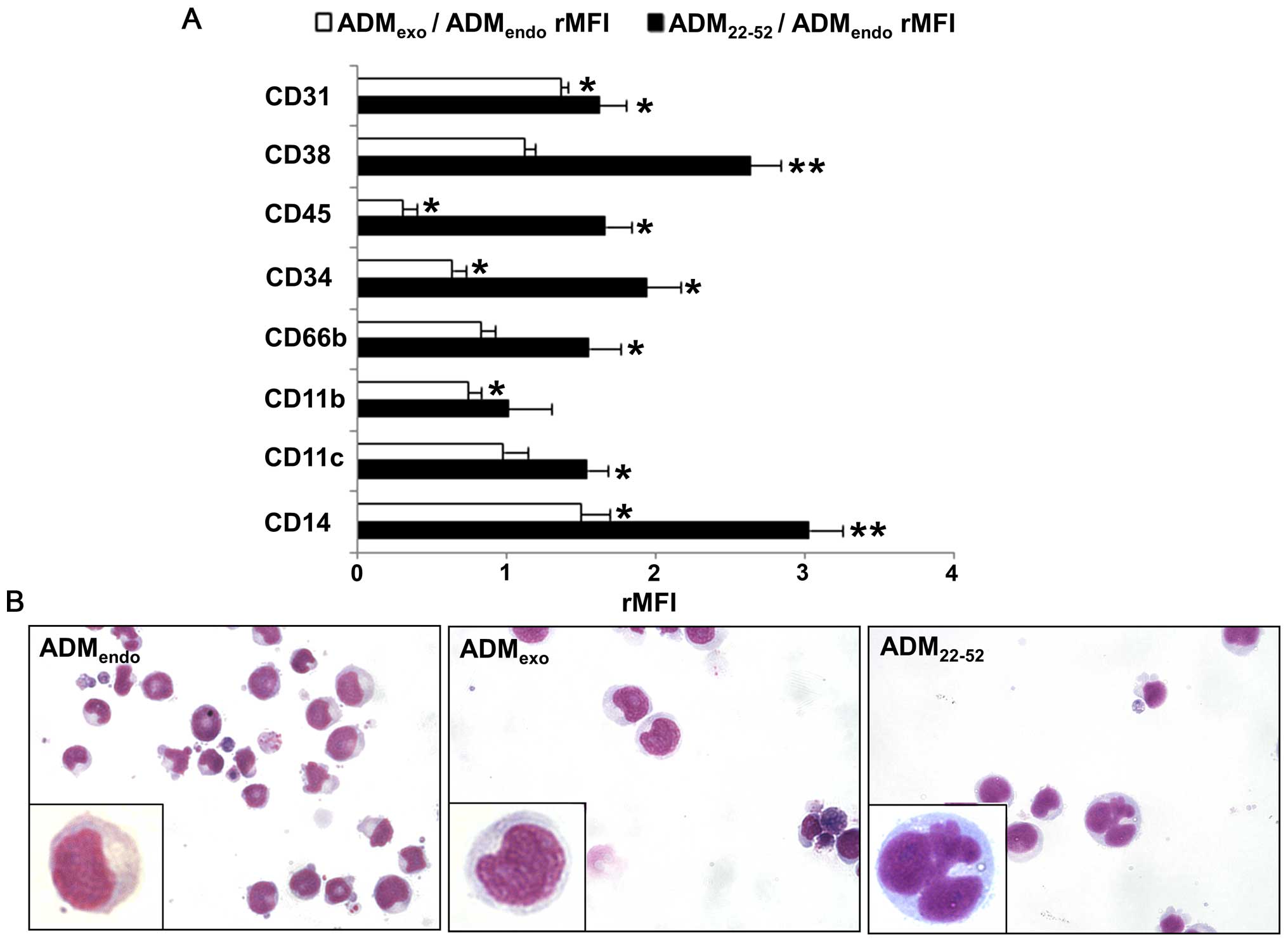 |
|
Korf K, Wodrich H, Haschke A, Ocampo C, Harder L, Gieseke F, Pollmann A, Dierck K, Prall S, Staege H, et al: The PML domain of PML-RARα blocks senescence to promote leukemia. Proc Natl Acad Sci USA. 111:12133–12138. 2014. View Article : Google Scholar | |
|
Nitto T and Sawaki K: Molecular mechanisms of the anti-leukemia activities of retinoid and arsenic. J Pharmacol Sci. 126:179–185. 2014. View Article : Google Scholar | |
|
Kitamura K, Kangawa K, Kawamoto M, Ichiki Y, Nakamura S, Matsuo H and Eto T: Adrenomedullin: A novel hypotensive peptide isolated from human pheochromocytoma. 1993. Biochem Biophys Res Commun. 425:548–555. 2012. View Article : Google Scholar : PubMed/NCBI | |
|
Kitamura K, Kangawa K and Eto T: Adrenomedullin and PAMP: Discovery, structures, and cardiovascular functions. Microsc Res Tech. 57:3–13. 2002. View Article : Google Scholar : PubMed/NCBI | |
|
Andreis PG, Mazzocchi G, Rebuffat P and Nussdorfer GG: Effects of adrenomedullin and proadrenomedullin N-terminal 20 peptide on rat zona glomerulosa cells. Life Sci. 60:1693–1697. 1997. View Article : Google Scholar : PubMed/NCBI | |
|
Dickerson IM: Role of CGRP-receptor component protein (RCP) in CLR/RAMP function. Curr Protein Pept Sci. 14:407–415. 2013. View Article : Google Scholar : PubMed/NCBI | |
|
Shindo T, Sakurai T, Kamiyoshi A, Ichikawa-Shindo Y, Shimoyama N, Iinuma N, Arai T and Miyagawa S: Regulation of adrenomedullin and its family peptide by RAMP system: lessons from genetically engineered mice. Curr Protein Pept Sci. 14:347–357. 2013. View Article : Google Scholar : PubMed/NCBI | |
|
Tixier E, Leconte C, Touzani O, Roussel S, Petit E and Bernaudin M: Adrenomedullin protects neurons against oxygen glucose deprivation stress in an autocrine and paracrine manner. J Neurochem. 106:1388–1403. 2008. View Article : Google Scholar : PubMed/NCBI | |
|
Shichiri M and Hirata Y: Regulation of cell growth and apoptosis by adrenomedullin. Hypertens Res. 26(Suppl): S9–S14. 2003. View Article : Google Scholar : PubMed/NCBI | |
|
Larráyoz IM, Martínez-Herrero S, García-Sanmartín J, Ochoa-Callejero L and Martínez A: Adrenomedullin and tumour microenvironment. J Transl Med. 12:3392014. View Article : Google Scholar : PubMed/NCBI | |
|
Berenguer-Daizé C, Boudouresque F, Bastide C, Tounsi A, Benyahia Z, Acunzo J, Dussault N, Delfino C, Baeza N, Daniel L, et al: Adrenomedullin blockade suppresses growth of human hormone-independent prostate tumor xenograft in mice. Clin Cancer Res. 19:6138–6150. 2013. View Article : Google Scholar : PubMed/NCBI | |
|
Nikitenko LL, Fox SB, Kehoe S, Rees MC and Bicknell R: Adrenomedullin and tumour angiogenesis. Br J Cancer. 94:1–7. 2006. View Article : Google Scholar | |
|
Rullé S, Ah Kioon MD, Asensio C, Mussard J, Ea HK, Boissier MC, Lioté F and Falgarone G: Adrenomedullin, a neuropeptide with immunoregulatory properties induces semi-mature tolerogenic dendritic cells. Immunology. 136:252–264. 2012. View Article : Google Scholar : PubMed/NCBI | |
|
Hojo Y, Ikeda U, Ohya K, Ichida M, Kario K, Takahashi M, Ikeda M, Minota S, Isumi Y, Minamino N, et al: Interaction between monocytes and vascular endothelial cells induces adrenomedullin production. Atherosclerosis. 155:381–387. 2001. View Article : Google Scholar : PubMed/NCBI | |
|
Kubo A, Minamino N, Isumi Y, Kangawa K, Dohi K and Matsuo H: Adrenomedullin production is correlated with differentiation in human leukemia cell lines and peripheral blood monocytes. FEBS Lett. 426:233–237. 1998. View Article : Google Scholar : PubMed/NCBI | |
|
Nakayama M, Takahashi K, Murakami O, Murakami H, Sasano H, Shirato K and Shibahara S: Adrenomedullin in monocytes and macrophages: Possible involvement of macrophage-derived adrenomedullin in atherogenesis. Clin Sci (Lond). 97:247–251. 1999. View Article : Google Scholar | |
|
Del Pup L, Belloni AS, Carraro G, De Angeli S, Parnigotto PP and Nussdorfer GG: Adrenomedullin is expressed in cord blood hematopoietic cells and stimulates their clonal growth. Int J Mol Med. 11:157–160. 2003.PubMed/NCBI | |
|
De Angeli S, Del Pup L, Febas E, Conconi MT, Tommasini M, Di Liddo R, Albertin G, Parnigotto PP and Nussdorfer GG: Adrenomedullin and endothelin-1 stimulate in vitro expansion of cord blood hematopoietic stem cells. Int J Mol Med. 14:1083–1086. 2004.PubMed/NCBI | |
|
Baxter SS, Carlson LA, Mayer AM, Hall ML and Fay MJ: Granulocytic differentiation of HL-60 promyelocytic leukemia cells is associated with increased expression of Cul5. In Vitro Cell Dev Biol Anim. 45:264–274. 2009. View Article : Google Scholar : PubMed/NCBI | |
|
Ziolkowska A, Budzynska K, Trejter M, Tortorella C, Belloni AS and Malendowicz LK: Effects of adrenomedullin and its fragment 22–52 on basal and ACTH-stimulated secretion of cultured rat adrenocortical cells. Int J Mol Med. 11:613–615. 2003.PubMed/NCBI | |
|
Livak KJ and Schmittgen TD: Analysis of relative gene expression data using real-time quantitative PCR and the 2(−Delta Delta C(T)) method. Methods. 25:402–408. 2001. View Article : Google Scholar | |
|
Paietta E, Goloubeva O, Neuberg D, Bennett JM, Gallagher R, Racevskis J, Dewald G, Wiernik PH and Tallman MS; Eastern Cooperative Oncology Group. A surrogate marker profile for PML/RAR alpha expressing acute promyelocytic leukemia and the association of immunophenotypic markers with morphologic and molecular subtypes. Cytometry B Clin Cytom. 59:1–9. 2004. View Article : Google Scholar : PubMed/NCBI | |
|
Guglielmi C, Martelli MP, Diverio D, Fenu S, Vegna ML, Cantù-Rajnoldi A, Biondi A, Cocito MG, Del Vecchio L, Tabilio A, et al: Immunophenotype of adult and childhood acute promyelocytic leukaemia: Correlation with morphology, type of PML gene breakpoint and clinical outcome. A cooperative Italian study on 196 cases. Br J Haematol. 102:1035–1041. 1998. View Article : Google Scholar : PubMed/NCBI | |
|
Taetle R, Ostergaard H, Smedsrud M and Trowbridge I: Regulation of CD45 expression in human leukemia cells. Leukemia. 5:309–314. 1991.PubMed/NCBI | |
|
Carrigan SO, Weppler AL, Issekutz AC and Stadnyk AW: Neutrophil differentiated HL-60 cells model Mac-1 (CD11b/CD18)-independent neutrophil transepithelial migration. Immunology. 115:108–117. 2005. View Article : Google Scholar : PubMed/NCBI | |
|
Kim KH, Seoh JY and Cho SJ: Phenotypic and functional analysis of HL-60 cells used in opsonophagocytic-killing assay for Streptococcus pneumoniae. J Korean Med Sci. 30:145–150. 2015. View Article : Google Scholar : PubMed/NCBI | |
|
Veselská R, Zitterbart K, Auer J and Neradil J: Differentiation of HL-60 myeloid leukemia cells induced by all-trans retinoic acid is enhanced in combination with caffeic acid. Int J Mol Med. 14:305–310. 2004.PubMed/NCBI | |
|
Newman PJ, Berndt MC, Gorski J, White GC II, Lyman S, Paddock C and Muller WA: PECAM-1 (CD31) cloning and relation to adhesion molecules of the immunoglobulin gene superfamily. Science. 247:1219–1222. 1990. View Article : Google Scholar : PubMed/NCBI | |
|
Brouwer RE, Hoefnagel J, Borger van Der Burg B, Jedema I, Zwinderman KH, Starrenburg IC, Kluin-Nelemans HC, Barge RM, Willemze R and Falkenburg JH: Expression of co-stimulatory and adhesion molecules and chemokine or apoptosis receptors on acute myeloid leukaemia: High CD40 and CD11a expression correlates with poor prognosis. Br J Haematol. 115:298–308. 2001. View Article : Google Scholar : PubMed/NCBI | |
|
Howard M, Grimaldi JC, Bazan JF, Lund FE, Santos-Argumedo L, Parkhouse RM, Walseth TF and Lee HC: Formation and hydrolysis of cyclic ADP-ribose catalyzed by lymphocyte antigen CD38. Science. 262:1056–1059. 1993. View Article : Google Scholar : PubMed/NCBI | |
|
Muller WA, Weigl SA, Deng X and Phillips DM: PECAM-1 is required for transendothelial migration of leukocytes. J Exp Med. 178:449–460. 1993. View Article : Google Scholar : PubMed/NCBI | |
|
Deaglio S, Morra M, Mallone R, Ausiello CM, Prager E, Garbarino G, Dianzani U, Stockinger H and Malavasi F: Human CD38 (ADP-ribosyl cyclase) is a counter-receptor of CD31, an Ig superfamily member. J Immunol. 160:395–402. 1998.PubMed/NCBI | |
|
Dianzani U, Funaro A, DiFranco D, Garbarino G, Bragardo M, Redoglia V, Buonfiglio D, De Monte LB, Pileri A and Malavasi F: Interaction between endothelium and CD4+CD45RA+ lymphocytes. Role of the human CD38 molecule. J Immunol. 153:952–959. 1994.PubMed/NCBI | |
|
Rocchi P, Boudouresque F, Zamora AJ, Muracciole X, Lechevallier E, Martin PM and Ouafik L: Expression of adrenomedullin and peptide amidation activity in human prostate cancer and in human prostate cancer cell lines. Cancer Res. 61:1196–1206. 2001.PubMed/NCBI | |
|
Zudaire E, Martínez A, Garayoa M, Pío R, Kaur G, Woolhiser MR, Metcalfe DD, Hook WA, Siraganian RP, Guise TA, et al: Adrenomedullin is a cross-talk molecule that regulates tumor and mast cell function during human carcinogenesis. Am J Pathol. 168:280–291. 2006. View Article : Google Scholar : PubMed/NCBI | |
|
Miyashita K, Itoh H, Sawada N, Fukunaga Y, Sone M, Yamahara K, Yurugi T and Nakao K: Adrenomedullin promotes proliferation and migration of cultured endothelial cells. Hypertens Res. 26(Suppl): S93–S98. 2003. View Article : Google Scholar : PubMed/NCBI | |
|
Belloni AS, Trejter M, Malendowicz LK and Nussdorfer GG: Adrenomedullin stimulates proliferation and inhibits apoptosis of immature rat thymocytes cultured in vitro. Peptides. 24:295–300. 2003. View Article : Google Scholar : PubMed/NCBI | |
|
Iwasaki H, Eguchi S, Shichiri M, Marumo F and Hirata Y: Adrenomedullin as a novel growth-promoting factor for cultured vascular smooth muscle cells: Role of tyrosine kinase-mediated mitogen-activated protein kinase activation. Endocrinology. 139:3432–3441. 1998.PubMed/NCBI | |
|
Andreis PG, Markowska A, Champion HC, Mazzocchi G, Malendowicz LK and Nussdorfer GG: Adrenomedullin enhances cell proliferation and deoxyribonucleic acid synthesis in rat adrenal zona glomerulosa: Receptor subtype involved and signaling mechanism. Endocrinology. 141:2098–2104. 2000. View Article : Google Scholar : PubMed/NCBI | |
|
Ikeda U, Kanbe T, Kawahara Y, Yokoyama M and Shimada K: Adrenomedullin augments inducible nitric oxide synthase expression in cytokine-stimulated cardiac myocytes. Circulation. 94:2560–2565. 1996. View Article : Google Scholar : PubMed/NCBI | |
|
Jacob A, Wu R and Wang P: Regulation of RAMP expression in diseases. Adv Exp Med Biol. 744:87–103. 2012. View Article : Google Scholar : PubMed/NCBI | |
|
Poyner DR, Sexton PM, Marshall I, Smith DM, Quirion R, Born W, Muff R, Fischer JA and Foord SM: International Union of Pharmacology. XXXII. The mammalian calcitonin gene-related peptides, adrenomedullin, amylin, and calcitonin receptors. Pharmacol Rev. 54:233–246. 2002. View Article : Google Scholar : PubMed/NCBI | |
|
Gibbons C, Dackor R, Dunworth W, Fritz-Six K and Caron KM: Receptor activity-modifying proteins: RAMPing up adrenomedullin signaling. Mol Endocrinol. 21:783–796. 2007. View Article : Google Scholar | |
|
McLatchie LM, Fraser NJ, Main MJ, Wise A, Brown J, Thompson N, Solari R, Lee MG and Foord SM: RAMPs regulate the transport and ligand specificity of the calcitonin-receptor-like receptor. Nature. 393:333–339. 1998. View Article : Google Scholar : PubMed/NCBI | |
|
Steelman LS, Pohnert SC, Shelton JG, Franklin RA, Bertrand FE and McCubrey JA: JAK/STAT, Raf/MEK/ERK, PI3K/Akt and BCR-ABL in cell cycle progression and leukemogenesis. Leukemia. 18:189–218. 2004. View Article : Google Scholar : PubMed/NCBI | |
|
Brognard J, Clark AS, Ni Y and Dennis PA: Akt/protein kinase B is constitutively active in non-small cell lung cancer cells and promotes cellular survival and resistance to chemotherapy and radiation. Cancer Res. 61:3986–3997. 2001.PubMed/NCBI | |
|
Hsu J, Shi Y, Krajewski S, Renner S, Fisher M, Reed JC, Franke TF and Lichtenstein A: The AKT kinase is activated in multiple myeloma tumor cells. Blood. 98:2853–2855. 2001. View Article : Google Scholar : PubMed/NCBI | |
|
Nicholson KM and Anderson NG: The protein kinase B/Akt signalling pathway in human malignancy. Cell Signal. 14:381–395. 2002. View Article : Google Scholar : PubMed/NCBI | |
|
Nakatani K, Thompson DA, Barthel A, Sakaue H, Liu W, Weigel RJ and Roth RA: Up-regulation of Akt3 in estrogen receptor-deficient breast cancers and androgen-independent prostate cancer lines. J Biol Chem. 274:21528–21532. 1999. View Article : Google Scholar : PubMed/NCBI | |
|
Hayashi H, Tsuchiya Y, Nakayama K, Satoh T and Nishida E: Down-regulation of the PI3-kinase/Akt pathway by ERK MAP kinase in growth factor signaling. Genes Cells. 13:941–947. 2008. View Article : Google Scholar : PubMed/NCBI | |
|
Kohroki J, Nishiyama T, Nakamura T and Masuho Y: ASB proteins interact with Cullin5 and Rbx2 to form E3 ubiquitin ligase complexes. FEBS Lett. 579:6796–6802. 2005. View Article : Google Scholar : PubMed/NCBI | |
|
Kile BT, Schulman BA, Alexander WS, Nicola NA, Martin HM and Hilton DJ: The SOCS box: A tale of destruction and degradation. Trends Biochem Sci. 27:235–241. 2002. View Article : Google Scholar : PubMed/NCBI | |
|
Fay MJ, Longo KA, Ka rathanasis GA, Shope DM, Mandernach CJ, Leong JR, Hicks A, Pherson K and Husain A: Analysis of CUL-5 expression in breast epithelial cells, breast cancer cell lines, normal tissues and tumor tissues. Mol Cancer. 2:402003. View Article : Google Scholar : PubMed/NCBI | |
|
Kalla C, Scheuermann MO, Kube I, Schlotter M, Mertens D, Döhner H, Stilgenbauer S and Lichter P: Analysis of 11q22-q23 deletion target genes in B-cell chronic lymphocytic leukaemia: Evidence for a pathogenic role of NPAT, CUL5, and PPP2R1B. Eur J Cancer. 43:1328–1335. 2007. View Article : Google Scholar : PubMed/NCBI | |
|
Abdullah M and Seman Z: Role of signaling pathways in acute myeloid leukemia. Myeloid Leukemia-Basic Mechanisms of Leukemogenesis. Koschmieder S and Krug U: InTech; Rijeka: pp. 429–448. 2011 | |
|
Ozes ON, Mayo LD, Gustin JA, Pfeffer SR, Pfeffer LM and Donner DB: NF-kappaB activation by tumour necrosis factor requires the Akt serine-threonine kinase. Nature. 401:82–85. 1999. View Article : Google Scholar : PubMed/NCBI | |
|
Fukumoto S, Hsieh CM, Maemura K, Layne MD, Yet SF, Lee KH, Matsui T, Rosenzweig A, Taylor WG, Rubin JS, et al: Akt participation in the Wnt signaling pathway through Dishevelled. J Biol Chem. 276:17479–17483. 2001. View Article : Google Scholar : PubMed/NCBI | |
|
Sykes SM, Lane SW, Bullinger L, Kalaitzidis D, Yusuf R, Saez B, Ferraro F, Mercier F, Singh H, Brumme KM, et al: AKT/FOXO signaling enforces reversible differentiation blockade in myeloid leukemias. Cell. 146:697–708. 2011. View Article : Google Scholar : PubMed/NCBI | |
|
Marcinkowska E, Garay E, Gocek E, Chrobak A, Wang X and Studzinski GP: Regulation of C/EBPbeta isoforms by MAPK pathways in HL60 cells induced to differentiate by 1,25-dihy-droxyvitamin D3. Exp Cell Res. 312:2054–2065. 2006. View Article : Google Scholar : PubMed/NCBI | |
|
Trayner ID, Bustorff T, Etches AE, Mufti GJ, Foss Y and Farzaneh F: Changes in antigen expression on differentiating HL60 cells treated with dimethylsulphoxide, all-trans retinoic acid, alpha1,25-dihydroxyvitamin D3 or 12-O-tetradecanoyl phorbol-13-acetate. Leuk Res. 22:537–547. 1998. View Article : Google Scholar : PubMed/NCBI | |
|
Bellón T, López-Rodríguez C, Rubio MA, Jochems G, Bernabeu C and Corbi AL: Regulated expression of p150,95 (CD11c/CD18; αX/β2) and VLA-4 (CD49d/CD29; α4/β1) integrins during myeloid cell differentiation. Eur J Immunol. 24:41–47. 1994. View Article : Google Scholar | |
|
Park DJ, Chumakov AM, Vuong PT, Chih DY, Gombart AF, Miller WH Jr and Koeffler HP: CCAAT/enhancer binding protein epsilon is a potential retinoid target gene in acute promyelocytic leukemia treatment. J Clin Invest. 103:1399–1408. 1999. View Article : Google Scholar : PubMed/NCBI | |
|
van Lochem EG, van der Velden VH, Wind HK, te Marvelde JG, Westerdaal NA and van Dongen JJ: Immunophenotypic differentiation patterns of normal hematopoiesis in human bone marrow: Reference patterns for age-related changes and disease-induced shifts. Cytometry B Clin Cytom. 60:1–13. 2004. View Article : Google Scholar : PubMed/NCBI | |
|
Lewandowski D, Linassier C, Iochmann S, Degenne M, Domenech J, Colombat P, Binet C and Hérault O: Phosphatidylinositol 3-kinases are involved in the all-trans retinoic acid-induced upregulation of CD38 antigen on human haematopoietic cells. Br J Haematol. 118:535–544. 2002. View Article : Google Scholar : PubMed/NCBI | |
|
Hansen PB, Kjaersgaard E, Johnsen HE, Gram J, Pedersen M, Nikolajsen K and Hansen NE: Different membrane expression of CD11b and CD14 on blood neutrophils following in vivo administration of myeloid growth factors. Br J Haematol. 85:50–56. 1993. View Article : Google Scholar : PubMed/NCBI | |
|
Gallay N, Anani L, Lopez A, Colombat P, Binet C, Domenech J, Weksler BB, Malavasi F and Herault O: The role of platelet/endothelial cell adhesion molecule 1 (CD31) and CD38 antigens in marrow microenvironmental retention of acute myelogenous leukemia cells. Cancer Res. 67:8624–8632. 2007. View Article : Google Scholar : PubMed/NCBI | |
|
Lemischka IR: Microenvironmental regulation of hematopoietic stem cells. Stem Cells. 15(Suppl 1): 63–68. 1997. View Article : Google Scholar : PubMed/NCBI | |
|
Chiarini F, Lonetti A, Evangelisti C, Buontempo F, Orsini E, Evangelisti C, Cappellini A, Neri LM, McCubrey JA and Martelli AM: Advances in understanding the acute lymphoblastic leukemia bone marrow microenvironment: From biology to therapeutic targeting. Biochim Biophys Acta. ppi: S0167-4889(15)00293-1. 2015 View Article : Google Scholar | |
|
Bakondi B, Shimada IS, Perry A, Munoz JR, Ylostalo J, Howard AB, Gregory CA and Spees JL: CD133 identifies a human bone marrow stem/progenitor cell sub-population with a repertoire of secreted factors that protect against stroke. Mol Ther. 17:1938–1947. 2009. View Article : Google Scholar : PubMed/NCBI | |
|
Chute JP, Muramoto GG, Dressman HK, Wolfe G, Chao NJ and Lin S: Molecular profile and partial functional analysis of novel endothelial cell-derived growth factors that regulate hematopoiesis. Stem Cells. 24:1315–1327. 2006. View Article : Google Scholar | |
|
Williams CA and Lavik EB: Engineering the CNS stem cell microenvironment. Regen Med. 4:865–877. 2009. View Article : Google Scholar : PubMed/NCBI | |
|
Kocemba KA, van Andel H, de Haan-Kramer A, Mahtouk K, Versteeg R, Kersten MJ, Spaargaren M and Pals ST: The hypoxia target adrenomedullin is aberrantly expressed in multiple myeloma and promotes angiogenesis. Leukemia. 27:1729–1737. 2013. View Article : Google Scholar : PubMed/NCBI | |
|
Takahashi K, Morimoto R, Hirose T, Satoh F and Totsune K: Adrenomedullin 2/intermedin in the hypothalamopituitary-adrenal axis. J Mol Neurosci. 43:182–192. 2011. View Article : Google Scholar | |
|
Tsuruda T, Kato J, Kitamura K, Kuwasako K, Imamura T, Koiwaya Y, Tsuji T, Kangawa K and Eto T: Adrenomedullin: A possible autocrine or paracrine inhibitor of hypertrophy of cardiomyocytes. Hypertension. 31:505–510. 1998. View Article : Google Scholar : PubMed/NCBI | |
|
Shichiri M, Fukai N, Ozawa N, Iwasaki H and Hirata Y: Adrenomedullin is an autocrine/paracrine growth factor for rat vascular smooth muscle cells. Regul Pept. 112:167–173. 2003. View Article : Google Scholar : PubMed/NCBI | |
|
Lah JJ and Frishman WH: Adrenomedullin: A vasoactive and natriuretic peptide with therapeutic potential. Heart Dis. 2:259–265. 2000. | |
|
Mazzocchi G, Albertin G and Nussdorfer GG: Adrenomedullin (ADM), acting through ADM(22-52)-sensitive receptors, is involved in the endotoxin-induced hypotension in rats. Life Sci. 66:1445–1450. 2000. View Article : Google Scholar | |
|
Albertin G, Carraro G, Parnigotto PP, Conconi MT, Ziolkowska A, Malendowicz LK and Nussdorfer GG: Human skin keratinocytes and fibroblasts express adrenomedullin and its receptors, and adrenomedullin enhances their growth in vitro by stimulating proliferation and inhibiting apoptosis. Int J Mol Med. 11:635–639. 2003.PubMed/NCBI | |
|
Rebuffat P, Macchi C, Malendowicz LK and Nussdorfer GG: Up-regulation of adrenomedullin gene expression in the regenerating rat adrenal cortex. Int J Mol Med. 20:551–555. 2007.PubMed/NCBI |









